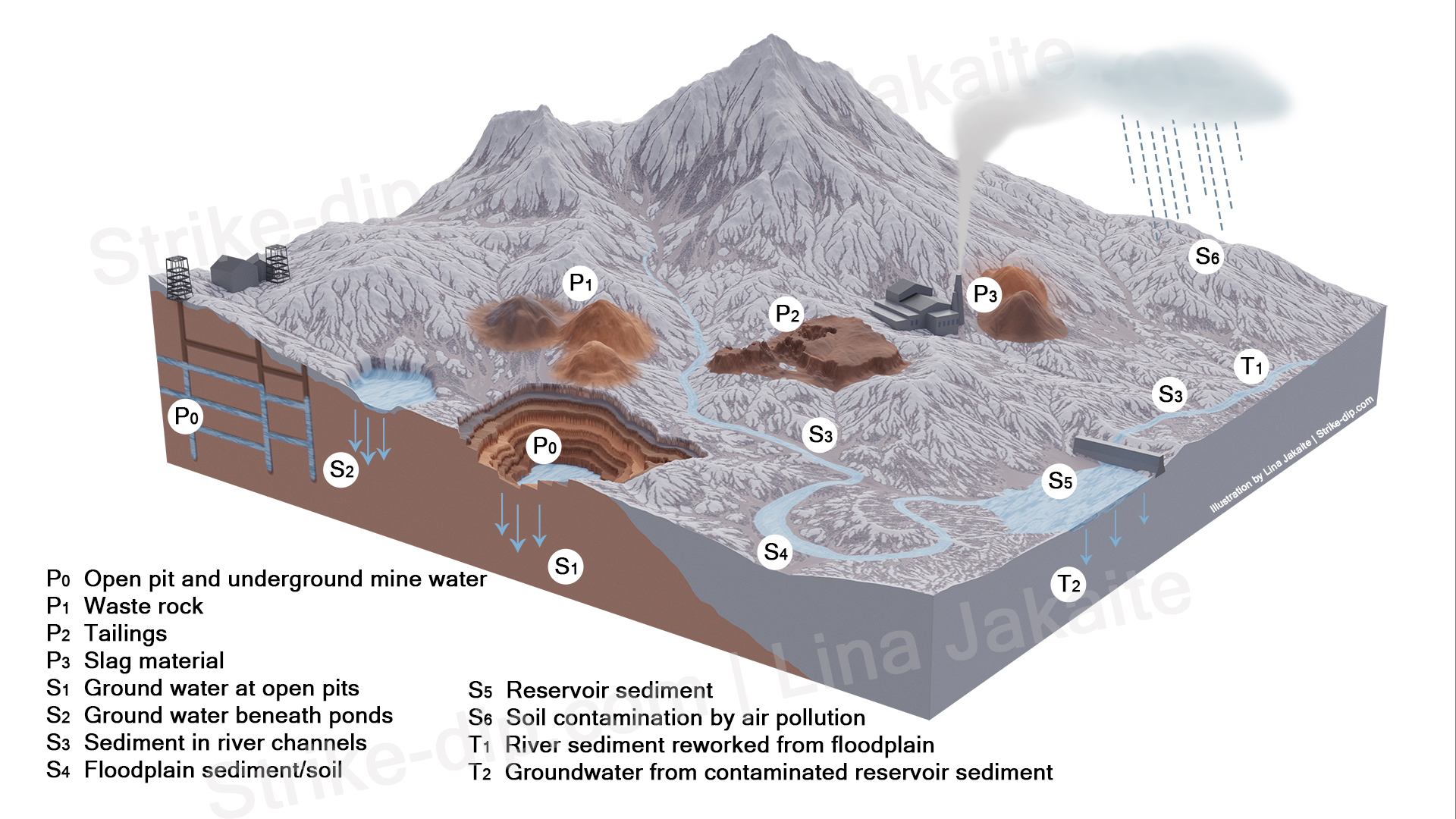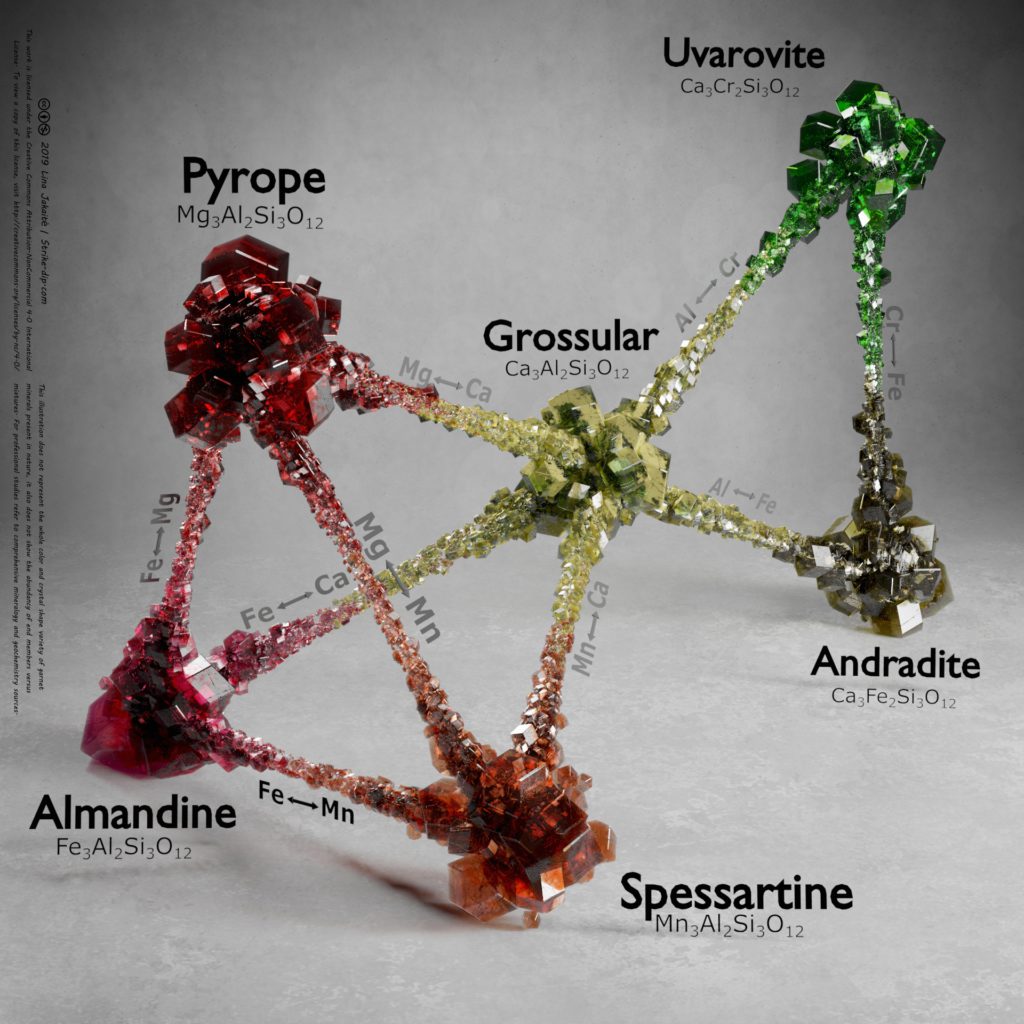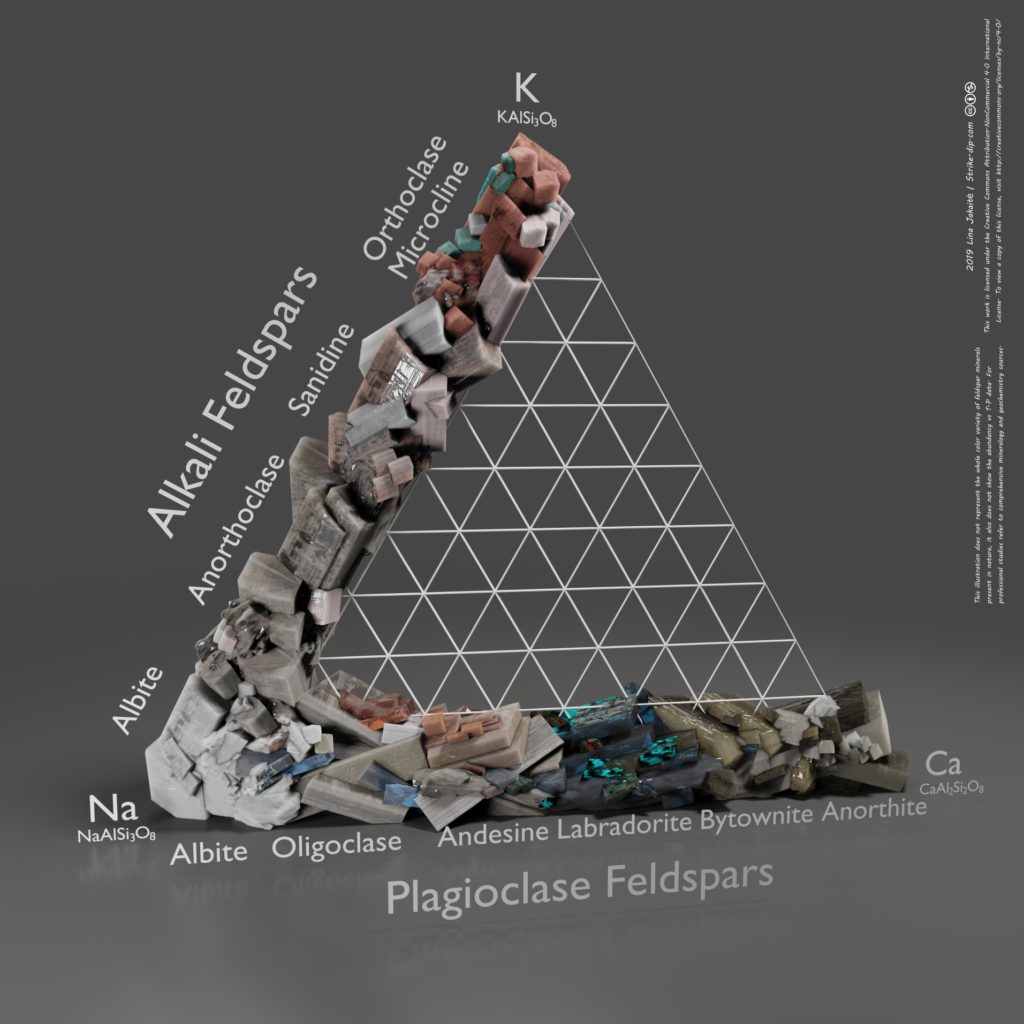Gallery
Salar hydroheology
In a recent years I had a few projects where I illustrated lithium brine related topics. These here are just a couple of illustrations from a bigger collection done for Zelandez company. Those pictures slightly differ from my usual art style but I love how they turned out! Truth to be told, I personally really like this simplistic style, even though it is not so obvious when looking at my published works :))
Magnetic signals from ocean tides
I’m on the journal cover! OK, not me exactly, but my illustration :))
Philosophical Transactions of the Royal Society. Vol. 382, Issue 2286
Honestly, I didn’t contribute any scientific insights to the article the illustration is associated with—I simply helped the authors present their study in a more visually engaging way. That said, the task wasn’t easy and straightforward. The illustration is built on real data, and authors, as always, challenged me with complex datasets as the foundation. Those colourful little arrows? They’re actual vector data—just reduced and 'polished' for visual simplicity purpose.
The article explores how the movement of ocean tides interacts with Earth's magnetic field to create faint magnetic signals. Using satellite data, these signals can be used to uncover details about the ocean floor and Earth's mantle, providing valuable insights into both Earth's interior and potential ocean changes over time.
Being a geologist I do get the main idea of the article, but I have to admit that I lack a deep understanding of the math and physics behind this study, so I wouldn’t dare to explain article’s deeper details here for you. If you’re curious about the essence of the research, it’s best to refer directly to one of the authors, Alexander Grayver´s, recent post here on LinkedIn: https://lnkd.in/e8RvRgdS
It has links to the article itself and few other, like ESA Swarm mission, which you might find interesting as well.
By the way, you'll find a breakdown of this illustration on Alexander's post.
It’s exciting, and I suppose it’s a small achievement to be proud of 🤭
Carbon Capture and Storage
A couple of illustrations done for InCapture. Both illustrations and more info can be found there: https://incapture.com.au/carbon-capture-and-storage/
Geological model
Some of my illustrations done for clients are not published (confidentiality or other reasons). So I decided to make a few illustrations with made up geology and dummy text - just to show a few examples of how the geological models can be visualized. With this one I just wanted to show that we don't necessary always need to use strict rectangle as a main shape of the 3D block. It can be any shape, any polygon. And the exploded view of the 3D model can improve the insight too.
Hydrogen
Natural hydrogen generation in intracratonic basin and ophiolites - a couple of illustration done for HydroGenesis. Captions for both illustrations as well as the full article can be found there: https://geoexpro.com/the-genesis-of-natural-hydrogen-exploration/
Atlantic Nickel Project
3D representation of a geological and geophysical data of Atlantic Nickel Project, Newfoundland, Canada.
Done for First Atlantic Nickel Corp. More info about the project itself on their website: https://www.fanickel.com/atlantic
Tectonic Plates
It is fun and relatively easy to do animations like this one. Once you have all the data. I had it already prepared because I used it for some of my previous projects. So I just had some fun playing with colors and textures while making this animation.
Kachi Project
Made some illustrations for Lake Resources on Kachi project. One of them is this 3D block diagram.
More info about the project can be found there: https://lakeresources.com.au/wp-content/uploads/2023/12/lke_kachi-dfs_19-dec-23.pdf
Ambient Noise Tomography
Ambient Noise Tomography Shear Wave model and depth slice illustrations done for Pulsar Helium.
Much of my work I publish is very much to the artistic side. However, in many cases they are based on real data. In this case the illustrations ARE the data.
Making illustrations like these brings me back to time when I was more of a geologist than illustrator :))
Offshore Geothermal
Image created for CGG's white paper 'Offshore Geothermal: A Green Energy Resource of Global Significance and its Responsible Development' (https://www.cgg.com/sites/default/files/2024-02/CGG_ISA_Offshore_Geothermal_White_Paper_2024.pdf)
Geological model
Some illustrations I've done for the companies are either confidential or not published yet. And it's a bit pity, because I do like how they turned out. So I though why not to make few illustrations with non existing geology and dummy text just to show you the style and look that can be achieved for some of your geological models and data. So, here is one of the examples. Geology, wells and other info can be represented like this.
Modelled minerals
None of these images are photos! Every mineral is modelled, every image is rendered.
What's the point of creating them? Fun! Or making some illustrations like I did for garnet and feldspar series, mineral shapes, etc. And I still have some more ideas!
Anyway, as a geologist, every time I post them somewhere, I feel a duty to inform the audience that these are modelled/created mineral images, even though for experienced eye it might be obvious :))
Check more illustrations there! https://strike-dip.com/modelled-minerals/
Lithium brine system
Lithium is quite a common topic in my illustrations recently. They often contain really beautiful geology, terrains and colors, like red-orange-brown-black mountains and volcanoes surrounding lakes and salars which are contrasting with white and pastel palette.
I've done this one for the CGG team to help illustrate their study. This illustration is just a little visual piece done for their further use in the poster.
Geology of Caves. How they form
Karst geology poster created for Southeastern Cave Conservancy (SCCi) (https://www.saveyourcaves.org/)
It illustrates cave formation processes and cave forms. Its not only a great education tool or decoration for your home but also a chance to support SCCi by purchasing this poster at their store: https://southeastern-cave-conservancy-inc.square.site/product/cave-geology-poster/155?cs=true&cst=custom
Shetland Islands Geology in watercolor
Painting geological maps in watercolor works as a coloring book for me – relaxes the mind. There is no specific reason why I choose one or another part of the world, I just find something interesting, shape, shoreline, bathymetry, geology, etc.
Geology shown there is a combination and simplification based on few online resources, therefore it obviously might be inaccurate in some places. But since the aim of this image is to be an artwork and not an actual map – all good, I guess :))
The whole map is quite big, so details are not visible on screen. Therefore, to highlight the texture of paper and watercolor I added few parts zoomed and cropped.
Aluto volcano's Subsurface structure, Ethiopian Rift
This illustration portrays the significant subsurface structures beneath Ethiopia's Aluto volcano, providing valuable insights into its deep-rooted magmatic plumbing system and the shallow magmatic system responsible for heating its volcano-hosted geothermal system.
The authors of the study (articles: https://library.seg.org/doi/10.1190/geo2022-0617.1 and https://agupubs.onlinelibrary.wiley.com/doi/10.1029/2022JB025849) used the geophysical imaging technique called magnetotellurics to unravel the subsurface architecture of the Aluto-Langano geothermal field in the Main Ethiopian Rift - home to the only operating geothermal power plant in Ethiopia. The study demonstrates the immense value of the magnetotelluric method for volcano imaging and for understanding magma-driven geothermal systems.
The foundation of the illustration was actual 3D data provided by the study authors, therefore you can recognize that main features, like the shape of the magma body shown in the illustration corresponds to the 3D models represented in the publications mentioned above.
Snowball Earth - Rodinia
Both versions, with text and without text: https://strike-dip.com/snowball-earth-rodinia/
Muography
Illustrations done for company specializing in muon tomography.
Although there are no labels in the first image - it is pretty easy to understand - blue trails are muon trails, white boxes are detectors in the boreholes and underground mines and the yellow body - ore body.
But there are plenty of info online, if you find this method interesting or unknown.
The last two images - just a couple of environment variations.
Tectonic Plates
I was working on the project regarding the rift system, also at the same time earthquakes in Turkey and Syria happened, so somehow naturally I drifted towards tectonics, and tectonic plates and thought that it would be interesting to make the 'exploded view' of the tectonic plates. I know there are a lot of them on internet, I just had an idea to make it in my style, with lava-glowing edges. However, while making first drafts and looking on the internet for the details I realized that in many cases, in such 'exploded view' illustrations there is a problem that all tectonic boundaries look like either divergent or transform but the subduction, or rather the subducted part of the plate is invisible and, even though there might be marking of the subduction edge it is still difficult to imagine, especially for non-geo person.
So I search for subduction data, found USGS Slab 2.0 data (https://www.usgs.gov/tools/slab20-interactive-map). Nice, clean, open data, articles available, etc., just google for more. And included that slab data into my animation.
The subduction slabs are all in scale, i.e. there is no vertical exaggeration. And what surprised me is how big and deep they are. I am not trying to pretend to be an expert in tectonics, so, yea, it did surprise me, as I, for some reason, had a picture in my head that they are more shallow.
The surface elevations are all flattened to 0, as it is so tiny compared to whole globe that is gives more visual noise to the animation than the actual benefit.
Also, simplified model at the exploded view is available on on sketchfab: https://skfb.ly/oEQTW
I am fully aware that some details regarding the plate boundaries or depths of the certain parts of the slabs might be debatable, or that something is too simplified. But I'll leave it to experts and as a disclaimer will call this animation a pop-geo-animation even though it is based on actual GIS data and is all in scale :)) Enjoy!
Geology art. Intrusions
I had this idea to make some of the intrusions as really hot and glowing bodies entrapped in a rock. Decided to make few of them at the same time experimenting and practicing with some of my workflows and techniques.
Of course, every geologist will recognize that those intrusions should be fully covered with rock layers and no gaps between layers themselves should be present. Therefore I want to stress out that this is artistic approach.
More intrusion themed illustrations there: https://strike-dip.com/geology-art-intrusions/
Vision on a UNESCO Global Geopark - Southeastern Dead Sea
Animation was done as part of the initiation of a UNESCO Global Geopark in Jordan - it presents the highlight area of sinkholes and subsidence at the Dead Sea. More info can be found under https://www.mdpi.com/2073-445X/11/4/549 and https://www.mdpi.com/2073-445X/11/4/553 .
New way to speed up tsunami warning
Emplacement and preservation of mineralized écaille within Roan Breccia of the Lufilian Arc
Animation and illustrations for an article:
https://link.springer.com/article/10.1007/s00126-022-01139-7
What's the color inside Earth?
Years ago, probably in my first years of studying geology, when I learned that huge part of Earth's mantle is olivine-green I was amazed by that fact. And at the same time I found it interesting that most of Earths structure illustrations show red-hot-glowing spheres and there's no clue about parts of it being green. So the green-mantle illustration idea was born long time ago :)) .
I am fully aware that the internal structure, thus colors are not that obvious and simple. In this illustration there is no representation of convection, plumes or subduction slabs. And the deeper you go the more theory based all is.
It's just the very basic, most common numbers and facts about the Earths structure illustrated but in slightly different perspective, to raise the curiosity and questions of What and Why??
By the way, interesting thing. I had an idea of showing half of it as hot-red and another part as 'cooled down'. I was struggling to find the nice balance for these red and yellow colors, how do I show it properly, how do I show one sphere hotter than other, but then again making sure they are all well visible. I was jumping back and forth with those colors, but when I saw Earths internal temperature graph somewhere and because it was in Kelvins somehow 'connecting the dots' moment happened and I realized that there is also the color spectrum for black body based on its temperature in Kelvins known. So what I did - I simply used black body color spectrum based on its temperature. So we can say that those hot colors are also true colors :))
Integrated Ground Model. Ten noorden van de Waddeneilanden Wind Farm Zone
Ten noorden van de Waddeneilanden Wind Farm Zone (TNWWFZ) is located 56 km off the north coast of the Netherlands. NGI and SAND Geophysics have developed an Integrated Ground Model of this area by combining knowledge from Geology, Geophysics and Geotechnical engineering. This model provides geotechnical design parameters for the complete 3D area.
Animation on youtube: https://youtu.be/JEenpiAU8Mk
Vittangi Graphite Project
This animation is focused on the geology of the Vittangi graphite, Northern Sweden. If you'd like to know more on where this graphite could and will be used check another video: https://youtu.be/d3-GRuNGZYI
Lunar Ice Textures
If you're interested to learn more go and check professor Kevin Cannon's website https://kevincannon.rocks/lunarmining/#textures
Two Billion Years in the Making - Greater Falun Project
'Two Billion Years in the Making - Greater Falun Project' animation shows the geological evolution of Falun (Sweden) area. It explains how different layers formed, what happened when rifting and opposite (compression) were dominant in the area, how the Cu-Au and polymetallic skarns (main targets) formed and why limestone layer present in the area is so helpful in prospecting.
Animation is accompanied with a bunch of illustrations. To see them all check this: https://strike-dip.com/two-billion-years-in-the-making-greater-falun-project/
Fault Juxtaposition Plots explained
How do we know if the fault leaks or seals? And what the Fault Juxtaposition Plot is? This animation might be helpful in understanding this.
Mine's pollution pathways
Link to full publication: https://www.wolkersdorfer.info/publication/pdf/Effects%20of%20Mining%20on%20Surface%20Water.pdf
Lake Wells Sulphate of Potash Project
Geological evolution of Lake Wells (West Australia) paleochannel. More about: https://strike-dip.com/lake-wells-sulphate-of-potash-project/
Witwatersrand gold deposition environments illustrated
Illustrations of Mesoarchaean-Neoarchaean environments within which the Witwatersrand-type gold deposits formed. Read more about what they show and what is the study behind them: https://strike-dip.com/witwatersrand/
Geology of West Lithuania
Short animation I did. A little piece of the Baltic sedimentary basin geology from west Lithuania.
Read more there: https://strike-dip.com/geology-of-west-lithuania/
Garnets
Garnet minerals are great group of silicate minerals with general chemical formula X3Y2Si3O12. X stands for divalent Ca, Mg, Fe and Mn cations and Y – for trivalent Al, Fe and Cr cations. There are two main groups of garnet minerals. One group is Uvarovite (Ca3Cr2Si3O12) – Grossular (Ca3Al2Si3O12) – Andradite (Ca3Fe2Si3O12) group. This group is called Ugrandite (based on the beginnings of garnet minerals names within this group). This group has calcium in X position and chromium, aluminum or iron in Y position. Uvarovite, Grossular and Andradite are end members of this group, but mixed compositions (example: Ca3(Al, Fe)Si3O12) are also common.
Another group: Pyrope (Mg3Al2Si3O12) – Almandine (Fe3Al2Si3O12) – Spessartine (Mn3Al2Si3O12). This group is called Pyralspite group. This group has aluminum in Y position and magnesium, iron or manganese in X position. All these three minerals can also blend with each other and form mixed minerals. Also, minerals of this group can blend to Grossular through calcium – magnesium, iron or manganese cations exchange. (Read more about illustration: https://strike-dip.com/garnets/)
High resolution poster there: https://gumroad.com/linajakaite
Porosity vs Saturation
100 % oil saturated core is not always that great!
All cores in each row have the same oil saturation but different porosity. Therefore, the total amount of oil differs a lot in each core.
This picture illustrates the very basics of Porosity vs Saturation. It does not discuss bulk or effective porosity, pore size, vugs, fractures, connected or isolated pores, more than one fluid, different phases, etc.
Higher resolution digital and paper posters there: https://gumroad.com/linajakaite
K2 from map to mountain
A bit of fun playing with real elevation data and combining textures. Animation made in Blender with Evee, but I needed a lot of World Machine help, a bit of Substance Painter and Designer and of course mapping software, in this case Surfer.
Feldspars
Feldspars are one of the most common minerals on Earth. There are two solid solution series of feldspar minerals: alkali feldspars and plagioclase feldspars. The end members of these solid solutions are potassium feldspar (orthoclase, microcline) (KAlSi3O8) – albite (NaAlSi3O8) – anorthite (CaAl2Si2O8). So, the alkali felspars range from orthoclase and microcline to albite. Accordingly, chemical formula of these minerals ranges from KAlSi3O8 to NaAlSi3O8 (because of K-Na substitution). And plagioclase feldspars range from albite to anorthite, so from NaAlSi3O8 to CaAl2Si2O8 (because of NaSi-CaAl substitution). Intermediate blended minerals are present for both sequences. (Read more about illustration: https://strike-dip.com/feldspars/)
High resolution poster available there: https://gumroad.com/linajakaite
Blue Desert
Just some fun with colors and shapes.
If you want PBR maps of this environment for your project you can get them there: https://gum.co/lLZic
QAPF, Gabbroic and Ultramafic Rock Classification Schemes
The idea with these pictures was to color them by using the colors (most common) of each corner mineral and blend these colors as the percentage of mineral changes. QAPF diagram represents only the normalized felsic (light colored minerals) part of the rock, so for this illustration I avoided adding mafic (dark colored) minerals. But after posting it on few social platforms, I realized that people naturally miss mafic minerals when they see granite, diorite or any other, especially gabbro. Similar situation with other schemes I posted there: https://strike-dip.com/rock_classification/. I have some ideas how to improve them. So, if you plan to copy these schemes and use them, either wait until I post improved versions or make sure you really understand why they are colored this way 😊





































